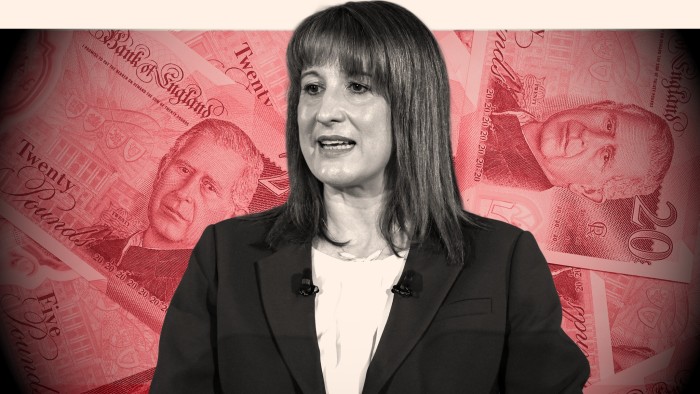Unlock the Editor’s Digest for free
Roula Khalaf, Editor of the FT, selects her favourite stories in this weekly newsletter.
A likely downgrade to the outlook for UK productivity will carve a bigger hole than expected in Rachel Reeves’ fiscal plans, the FT revealed on Monday — just as better economic data was starting to offer the chancellor some respite in the run-up to next month’s Budget.
The Office for Budget Responsibility’s switch to a more pessimistic view of the economy’s potential will increase pressure on Reeves to break Labour’s pre-election pledge and raise income tax in order to rebuild and increase her fiscal “headroom”.
But economists said there were still many moving parts in the watchdog’s forecast — and that some better news was emerging that could offset the damage done by the productivity downgrade.
What is happening on productivity?
The OBR’s judgment on trend productivity growth is the single biggest factor that will determine how far Reeves needs to tighten policy to meet her key fiscal target of balancing the current budget by 2029-30.
Until now, analysts had been expecting the fiscal watchdog to cut its forecast for trend productivity by 0.1-0.2 percentage points, to reflect the weak growth in the years since the global financial crisis and Brexit.
A 0.3 percentage point downgrade is now likely, according to people familiar with the matter. This could add more than £20bn to borrowing by 2027-2029, according to analyst estimates.
Each tenth of a percentage point lost from trend productivity could cost between £7bn and £9bn in the final year of the OBR forecast, economists say.
This adds to the pressure on Reeves to breach Labour’s election manifesto pledge on tax, with speculation growing of an income tax increase on November 26.
The Treasury said: “We won’t comment on speculation ahead of the OBR’s forecast, which will be published on November 26.”
What are Reeves’ other fiscal problems?
Reeves can blame previous governments for the UK’s historical record on productivity, and geopolitical developments beyond her control for the pressure to raise defence spending.
But other problems are of the current government’s own making.
The reversal of planned reforms to disability benefits and pensioners’ winter fuel payments will add £6bn — even before factoring in the intense pressure on ministers to scrap the two-child limit on benefits, which would cost an estimated £3.5bn.
Last year’s increase in employer national insurance contributions also looks to have both hit the labour market and added more than expected to inflation, limiting the scope for interest rate cuts by the Bank of England.
Where can she look for a silver lining?
Economic data over the past fortnight has offered some relief from recent unremitting gloom.
GDP growth had already overshot the OBR’s expectations in the first half of the year. Now retail sales are picking up and business surveys suggest the economy is regaining momentum after a summer lull.
The latest data on the public finances showed tax revenues have been broadly in line with the OBR’s expectations since March, as has central government spending — although borrowing has overshot as a result of slippage in local government finances.
Michael Saunders, adviser to the consultancy Oxford Economics, said one factor that could “limit the fiscal shortfall” was a likely upgrade in the OBR’s forecasts for wage growth and inflation. This could boost tax revenues by as much as £9bn in 2029-30, even after a bigger uprating of benefits, he said, while public spending would remain fixed in cash terms.
Robert Wood, chief UK economist at consultancy Pantheon Macroeconomics, said the BoE’s decision to slow the pace of bond sales over the next year could also save the Treasury some money — although this was not clear-cut.
What about bond markets?
A recent sharp fall in government borrowing costs could potentially hand Reeves back some £2bn-£3bn of fiscal room for manoeuvre — if it is not too late for the OBR to factor the drop into its forecasts.
The yield on two-year gilts fell to its lowest level for more than a year last week, as investors began to bet on earlier BoE rate cuts, and took heart from Reeves’ hints that she planned to build a bigger buffer against her fiscal rules than last year’s slim £9.9bn margin.
But this will only be reflected in the OBR’s forecasts if it fell within the period of 10 working days the agency uses to observe the market prices underpinning its projections.
The OBR has not yet disclosed the dates of its so-called observation for this year’s Budget — a reticence that Wood described as “a dreadful way to run a forecasting process”.
What would it take to offset the downgrade?
If Reeves were contending only with a modest downgrade in trend productivity, lower borrowing costs and stronger prospects for tax revenues would go a long way to offsetting the damage, Wood noted.
Reeves will also be hoping that the OBR gives the government credit for planning reforms, new trade deals and a rapprochement with the EU that could boost economic growth in the long term.
But these recent policy announcements are “unlikely to alter things much either way”, in Saunders view, as recent trade overtures would be offset by higher US tariffs, and a prospective UK-EU youth mobility deal looked set to be strictly limited in numbers.
A bold move to build more headroom against the borrowing rule, tackle welfare reform, or revisit the manifesto pledge on personal taxes, would also restore the government’s credibility in bond markets, analysts said.
But none of these factors is likely to offset the impact of a productivity downgrade of the size the OBR is now envisaging.
This article has been amended to clarify that a 0.1 percentage point reduction in productivity growth is estimated to equate to a £7bn to £9bn hit to the public finances.
 https://www.profitablecpmrate.com/nsirjwzb79?key=c706907e420c1171a8852e02ab2e6ea4
Skip to content
https://www.profitablecpmrate.com/nsirjwzb79?key=c706907e420c1171a8852e02ab2e6ea4
Skip to content 